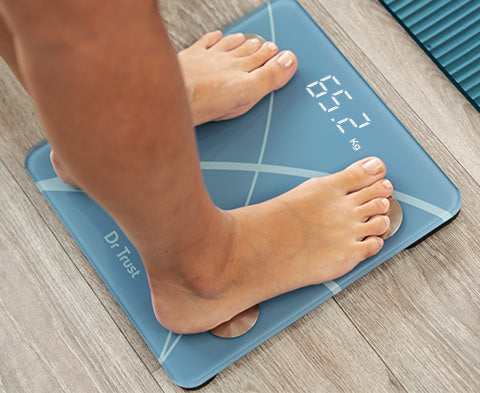Ranked No.1 Home Healthcare Brand in India
Ranked No.1 Home Healthcare Brand in India
Ranked No.1 Home Healthcare Brand in India
Ranked No.1 Home Healthcare Brand in India

In recent years, the global obesity epidemic has accentuated interest in body fat, comorbidities associated with it.
This article aims to get you acquainted with obesity via body fat in terms of visceral fat and subcutaneous fat, how are they associated with various health risks, and strategies to diagnose and get rid of it.
What are Visceral and Subcutaneous fat?
The fat beneath your skin that you can pinch is the subcutaneous fat, whereas the one lining internal organs is the visceral fat. Both fats serve as an essential cushion and insulate our body and organs from heat and cold.
The percentage of body fat typically increases with age, though different trends are observed for males and females.
Females accumulate more subcutaneous fat during and after puberty, whereas males deposit more visceral fat in the abdominal region after puberty.1
The fat distribution also depends on menopause status in women. In pre-menopausal women, subcutaneous fat is higher whereas, in post-menopausal women, both visceral fat and subcutaneous fat ratios are higher.
Physically, it’s hard to determine how much visceral fat and subcutaneous fat are present in your body. However, a bulging belly and large waist size are two visible signs that you have too much of it.
Too much fat in the body is attributed to energy imbalance between consumed calories and expended calories. The extra calories are further associated with unhealthy eating patterns, a sedentary lifestyle or it might be running in genes and is associated with various health risks irrespective of gender or age.
Health risks factors linked to increased body fat
Visceral fat accumulation is associated with Hypertension, Adult-Onset Diabetes Mellitus, Gallstones, Arthritis, and increased predisposition to Cancers of the Colon, Breast, and Prostate with prolonged hospital stays.2 It also leads to increased low-density lipoprotein (LDL), bad cholesterol levels, and decreased high-density lipoprotein (HDL), good cholesterol levels.
In contrast, some findings suggest that subcutaneous fat has a protective role in the body. 2 However, the increased subcutaneous fat levels contribute to joint issues, Type 2 diabetes, Strokes, Hypertension, Sleep Apnea, and a certain type of Cancers.
Both visceral fat and subcutaneous fat are associated with adverse cardiovascular risk factors, but visceral fat deposition is more threatning.3
Besides, a study conducted in California, reported that being overweight or obese in middle age has a higher risk of Dementia in later life.6
How to diagnose body fat?
CT, MRI, and DEXA are three direct clinical approaches to measuring cross-sectional areas of visceral fat in both adults and infants.5
BMI is also a surrogate assessment tool for determining obesity. BMI greater than 25 kg/m2 is categorized as overweight while a BMI over 30 kg/m2 is characterized as obese. Despite its popularity, BMI is not able to distinguish between visceral fat and subcutaneous fat.
Other Clinical measurements include skinfold Callipers, Waist-to-hip ratio (WHR), waist circumference (WC), waist-to-height ratio (WHtR), and abdominal subcutaneous tissue thickness (ASTT).
Waist circumference determines both visceral and subcutaneous fat, waist-to-height ratio (WHtR) determines visceral fat while Waist-to-hip ratio determines only subcutaneous fat.
WHO states normal Waist-to-hip ratio should be 0.90 for males and 0.85 for females. The ratio beyond these figures is categorized as abdominal obesity.
Calculate your waist-to-hip ratio
Likewise, the ideal waist-to-height ratio (WHtR) for men and women should be 0.5.
The waist-to-height ratio (WHtR) above 0.50 determines increased risk while the ratio above 0.60 determines substantial risk.9
Calculate your waist-to-height ratio
A larger waist circumference also indicates a high visceral fat percentage.

The abdominal subcutaneous tissue thickness (ASTT) can be measured at the abdominal midline, 4 cm above the umbilicus, using an inelastic tape.7
It’s been suggested that waist sizes of 32 inches for women and 35 inches for men are considered normal. While men with a waist size of 43 inches and above and women with a waist size over 41 inches and above are considered obese.4
Among all, BIA is a cost-effective, simple, and portable method to determine body composition, maintaining good general health and longevity.
BIA-based Body composition scales are revolutionary quick estimation weighing scales increasingly used at home for weight and body fat follow-up.

They have been shown to increase the frequency of self-weighing and monitoring the weight loss plan based on a healthy diet and physical activities.
These scales are formulated to connect to your smartphones, via fitness apps and help you engage in physical activity and healthy nutritional habits conveniently.8
Evaluate your body fat % with Dr Trust wide range of Smart weighing Scales
How to get rid of visceral fat and subcutaneous fat?
Subcutaneous fat is comparatively soft, and there are several treatment options available to get rid of it. Cryolipolysis, Laser Treatment, Injectable Deoxycholic Acids, Ultrasound Fat Reduction, and Red Light Therapy are the non-surgical approaches to getting rid of excess body belly fat.10
While Liposuction is the only surgical approach for the removal of excess subcutaneous fat.11
It’s better to consult a certified cosmetic surgeon before settling for any treatment for fat removal.
Besides, for a healthy body that is on verge of fat accumulation, Physical exercise in combination is a hypocaloric diet, low in carbs and high in protein and fiber can significantly reduce subcutaneous fat levels.

Cutting on processed foods, rich in trans fatty acids can potentially promote overall fat loss in the body.12
Get your AI diet plan for weight loss
Lifestyle modifications, reduced stress levels, and improved sleep quality also work for some people.
Cutting on high-calorie refined sugar can also change the weight loss game.
Unfortunately, there is no clinical treatment to get rid of visceral fat except for lifestyle modification, healthy eating habits, and physical activities.
Comments
Leave a comment